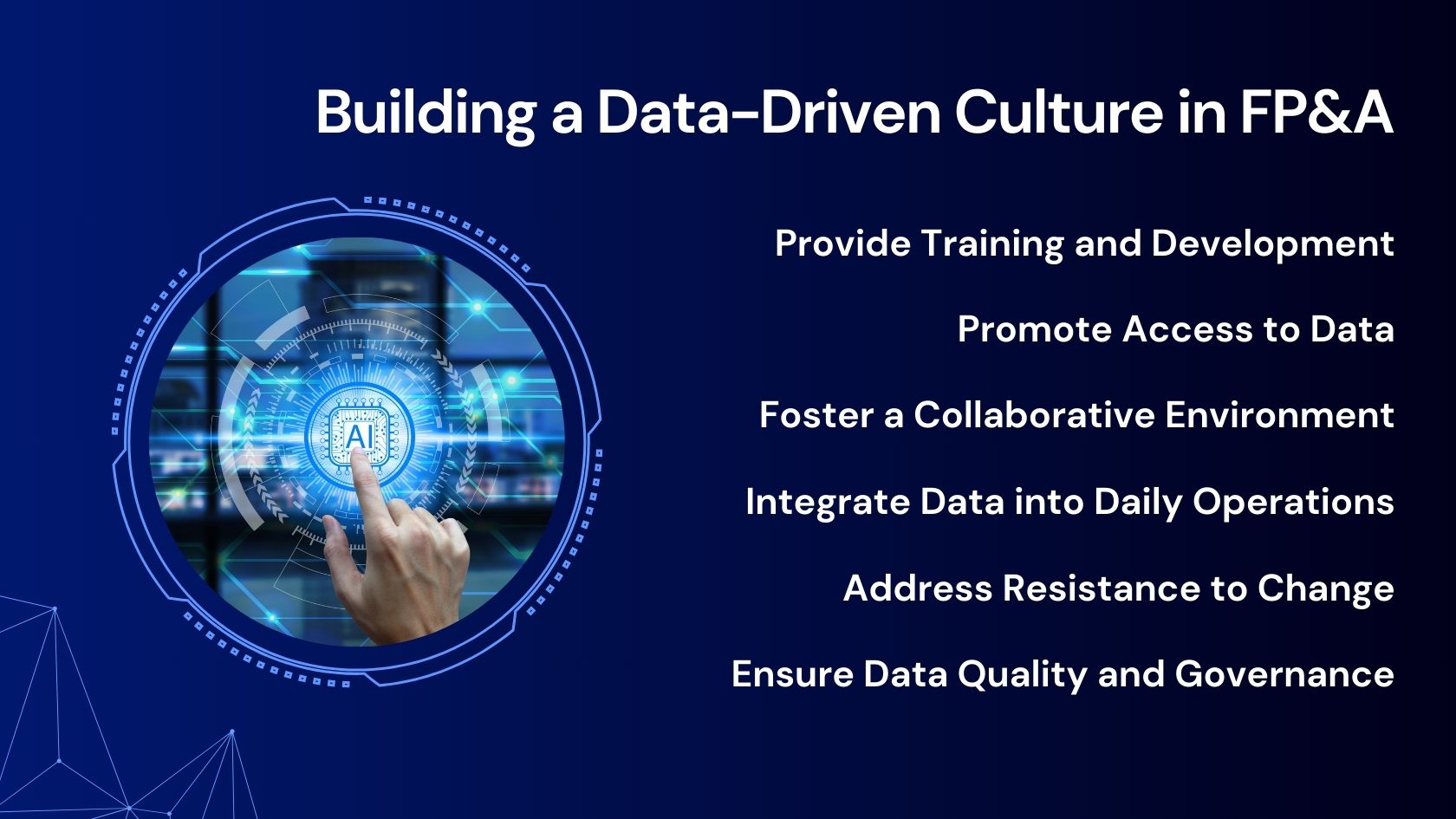Add Your Heading Text Building a Data-Driven Culture in FP&A
In the rapidly evolving business landscape, a data-driven culture is essential for organizations looking to enhance their decision-making processes, particularly in Financial Planning and Analysis (FP&A). As financial environments become more complex, FP&A teams must harness the power of data to drive insights, improve forecasting accuracy, and make informed strategic decisions. This article explores how FP&A teams can encourage data literacy and foster a data-driven culture that empowers all stakeholders.
Understanding a Data-Driven Culture
What is a Data-Driven Culture?
A data-driven culture is one where decision-making is based on data analysis and interpretation rather than intuition or experience alone. In FP&A, this culture involves not only using data for financial reporting and forecasting but also ensuring that all team members and stakeholders understand how to interpret and leverage data effectively in their roles.

Strategies for Encouraging Data Literacy
1. Provide Training and Development
Invest in Data Literacy Programs: Implement training programs focused on data analysis tools, statistical methods, and data interpretation. Workshops and online courses can enhance team members’ skills and confidence in working with data.
Encourage Cross-Departmental Learning: Foster knowledge sharing between FP&A and other departments. This can include joint training sessions that highlight how data impacts different areas of the business, promoting a holistic understanding of data usage.
2. Promote Access to Data
Centralize Data Sources: Create a centralized data repository that provides easy access to relevant financial and operational data. Using dashboards and data visualization tools can help simplify complex data and make it more accessible.
Encourage Self-Service Analytics: Equip team members with tools that allow them to conduct their analyses without always relying on the FP&A team. Self-service analytics platforms enable users to explore data, run reports, and generate insights independently.
3. Foster a Collaborative Environment
Encourage Team Collaboration: Create cross-functional teams that bring together diverse perspectives. Regularly scheduled meetings that focus on data-driven insights can promote collaboration and idea sharing.
Establish Data Champions: Identify individuals within the FP&A team and other departments who are passionate about data. These data champions can advocate for data literacy, support their peers, and drive initiatives that enhance the data-driven culture.
Creating a Data-Driven Decision-Making Process
4. Integrate Data into Daily Operations
Embed Data in Meetings: Make data a central part of discussions in meetings and decision-making processes. Use data-driven insights to support agenda items, ensuring that decisions are based on facts and analysis.
Develop Standard Operating Procedures: Establish guidelines for how data should be used in decision-making processes. This includes defining how to collect, analyze, and report data consistently across the organization.
5. Measure and Share Success
Track Data Usage: Monitor how often data is accessed and utilized in decision-making. This can provide insights into the effectiveness of training programs and highlight areas for further improvement.
Share Success Stories: Highlight instances where data-driven decisions led to successful outcomes. Sharing case studies and testimonials can motivate team members to embrace data-driven practices and reinforce the value of a data-centric approach.
Overcoming Challenges
6. Address Resistance to Change
Communicate the Benefits: Clearly communicate the advantages of a data-driven culture, such as improved forecasting accuracy, enhanced decision-making, and increased operational efficiency. Address any concerns and emphasize how data can empower employees in their roles.
Be Patient and Persistent: Changing organizational culture takes time. Encourage small wins and celebrate progress, while consistently reinforcing the importance of data literacy and analysis.
7. Ensure Data Quality and Governance
Implement Data Governance Practices: Establish clear data governance policies to ensure data quality, integrity, and consistency. Regular audits and validation processes can help maintain high standards.
Encourage Ethical Data Usage: Educate team members about ethical considerations in data usage, including compliance with regulations and responsible data management practices.
Conclusion
Building a data-driven culture within FP&A is essential for enhancing decision-making and fostering a more informed financial environment. By encouraging data literacy, promoting access to data, fostering collaboration, and integrating data into daily operations, FP&A teams can create an organizational culture that values and leverages data. As organizations continue to navigate complex financial landscapes, a strong data-driven culture will empower FP&A professionals to drive insights and contribute to strategic success. Embracing this shift not only enhances individual performance but also positions the organization for sustained growth and resilience in an increasingly data-centric world.
